Florida is home to thousands of species of crabs that vary widely in size, shape, color, diet, and more. Although it’d be nearly impossible to cover every single one of them, we’ve compiled a list of more than 15 of Florida’s most fascinating, incredible, and unique types of crabs you should know about, whether you’re a Sunshine State native or just plan on visiting. Keep reading to learn all about them and what they look like, as well as some interesting facts about each!
1. Florida Stone Crab (Menippe mercenaria)

Florida stone crabs’ claws are a delicacy, particularly in Florida where the species is abundant.
©vichie81/Shutterstock.com
The Florida stone crab is one of Florida’s most popular and well-known crabs, mainly due to its claws being a popular and delicious food source! Incredibly, though, the stone crab can regenerate its lost claws throughout around 8 to 12 months. This allows fisheries to harvest the crabs’ claws yearly without fatally wounding them. Although this crab is average in size overall, with a 5-to-6-inch carapace, a single claw can weigh close to 10 ounces.
2. Blue Land Crab (Cardisoma guanhumi)
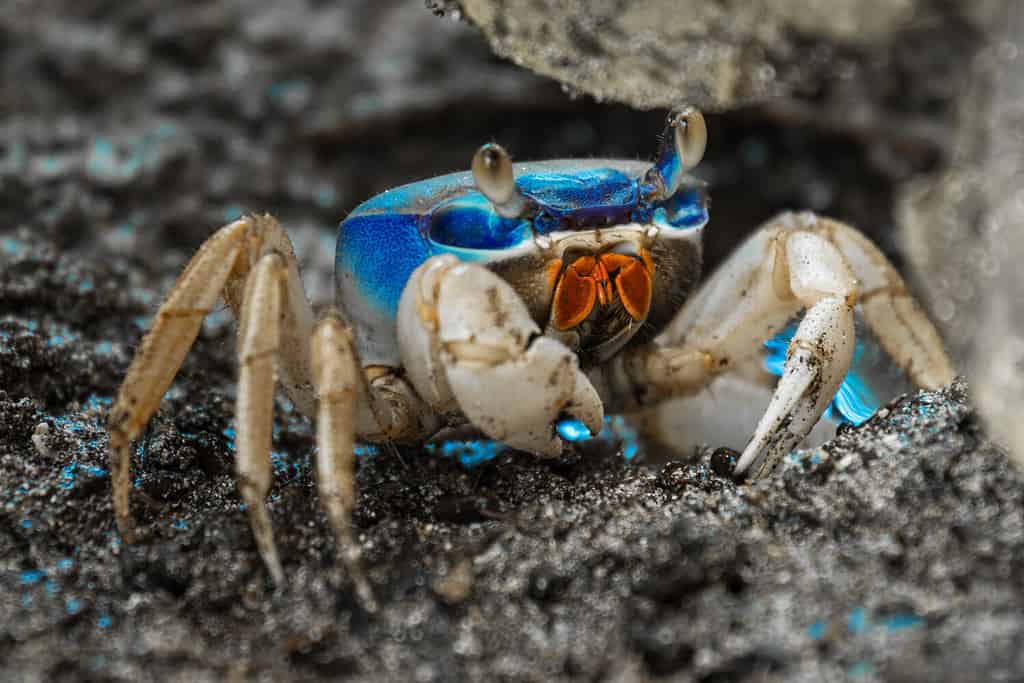
The blue land crab’s carapace ranges in color from bright blue to a ghostly gray.
©Dudarev Mikhail/Shutterstock.com
The blue land crab gets its name from the color of its carapace, which can vary in color from a vibrant royal blue to pale gray. It’s also one of Florida’s most prominent edible crabs aside from the stone crab and golden crab. It prefers warm tropical and subtropical waters near the Caribbean Islands and South America. However, it can be found as far north as southern Florida.
Notably, the blue land crab has a keen sense of hearing. It heavily relies on sound to search for food like insects and falling fruits from nearby trees, though it can occasionally resort to cannibalism.
3. Jonah Crab (Cancer borealis)
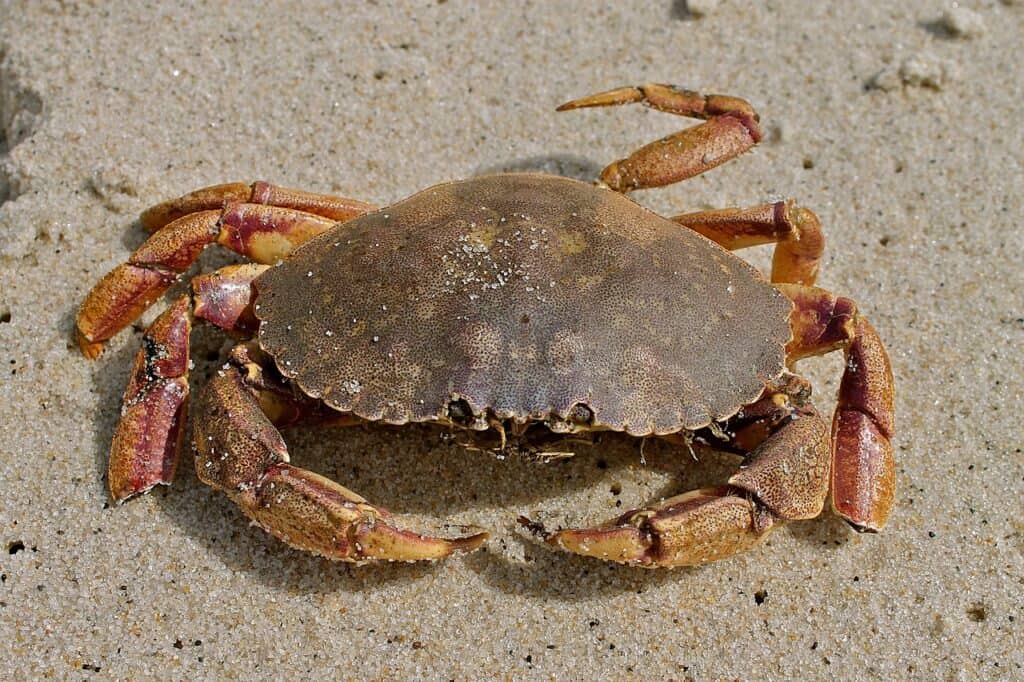
The Jonah crab’s sweet, mild taste makes it a popular choice for flavoring broths and soups.
©U.S. Fish and Wildlife Service Northeast Region / Creative Commons – License
Historically, the Jonah crab has long been considered to be something of a pest, as it is often caught as a bycatch in fisheries’ lobster traps. Its common name is a reference to the biblical character Jonah, who was swallowed by a whale and is associated with bad luck. However, in more recent years, it has become more popular as an edible crab. This is thanks to its rather sweet taste, which many use to flavor broths and soup-style dishes.
4. Sand Fiddler Crab (Leptuca pugilator)

This male sand fiddler crab commonly moves its large claw in a fiddling motion to attract females.
©Tory Kallman/Shutterstock.com
The sand fiddler crab is one of around 100 unique species of fiddler crabs. Male fiddler crabs always have one claw that is much larger than the other. Their common name references the way they often hold and move their claws in a “fiddling” motion when attempting to attract mates.
Sand fiddler crabs are especially abundant in Florida’s coastal mudflats. They often burrow into the soft sand and muddy substrate to evade predators. Additionally, they use their burrows as shelter during the winter months, during which they enter a hibernation state.
5. Atlantic Mole Crab (Emerita talpoida)

Also known as sand fleas, Atlantic mole crabs are one of Florida’s smallest crab species.
©iStock.com/Jaimie Tuchman
The Atlantic mole crab is perhaps better known to Florida locals as the sand flea for its small size and flea-like body shape. It’s one of Florida’s smallest crabs, typically only reaching an inch long at most. It filter feeds by burrowing its body backward into the sand and raising its long, feathery antennae to filter out plankton and algae.
Although shorebirds occasionally feed on the Atlantic mole crab, the species is fairly adept at avoiding predation. This is due to its ability to burrow into sandy substrate very quickly and its sandy-colored, well-camouflaged carapace.
6. Speckled Swimming Crab (Arenaeus cribrarius)
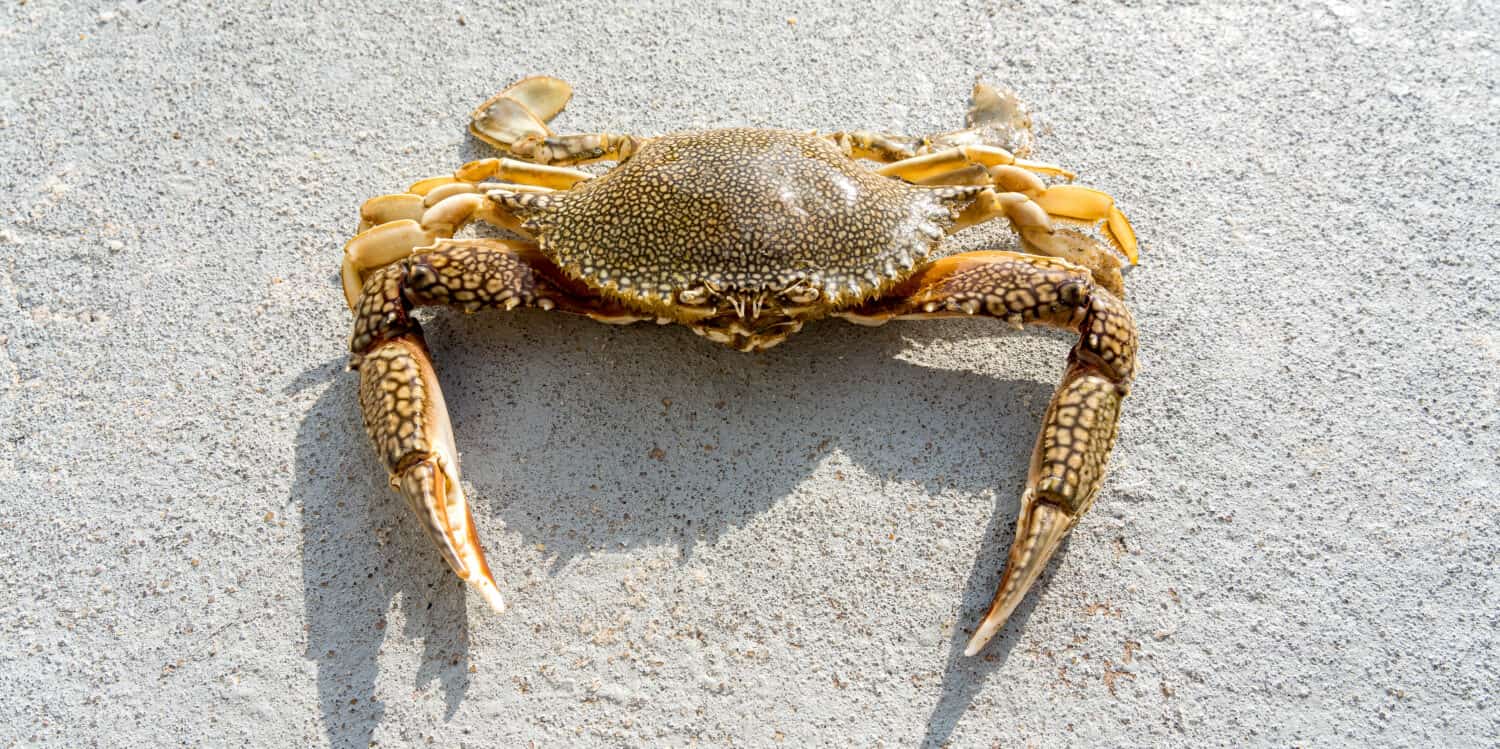
White speckled crabs are nocturnal and solitary, rarely even interacting with other members of their species.
©Sergey and Marina Pyataev/Shutterstock.com
The speckled swimming crab gets its common name from its handsomely white-speckled carapace. As a swimming crab, it is fairly closely related to the well-known blue crab. They often burrow into the sand, where they leave just enough of their bodies above the surface so water can access their gills.
Despite their vibrant coloration, these particular crabs are nocturnal and strictly solitary, refusing to even interact with other members of their species aside from breeding. Though they mainly feed on ocean detritus, speckled swimming crabs also sometimes eat small fish, mollusks, and even other, smaller crustaceans. In rare cases, they will even attempt to feed on sea turtle hatchlings that unintentionally venture too close to their burrows.
7. Red-Jointed Fiddler Crab (Minuca minax)

The red-jointed fiddler crab’s joints around its limbs and claws range in color from a dull orange to bright red.
©Mike Raube-Boyer/Shutterstock.com
The red-jointed fiddler crab is abundant throughout Florida’s salt marshes. Interestingly, they tend to avoid waters with high salinity. Instead, they prefer water that is far less salty compared to most other crabs. As their common name implies, the joints around their limbs and particularly their claws are a vibrant red.
Like most fiddler crabs, the males of this species have one claw that is much larger than the other. When attracting females, it will raise and move its large claw in a fiddling motion. Red-jointed fiddler crabs breed once a year every summer for around two weeks, usually in a burrow dug by the male with the help of its massive claw.
8. Mangrove Tree Crab (Aratus pisonii)
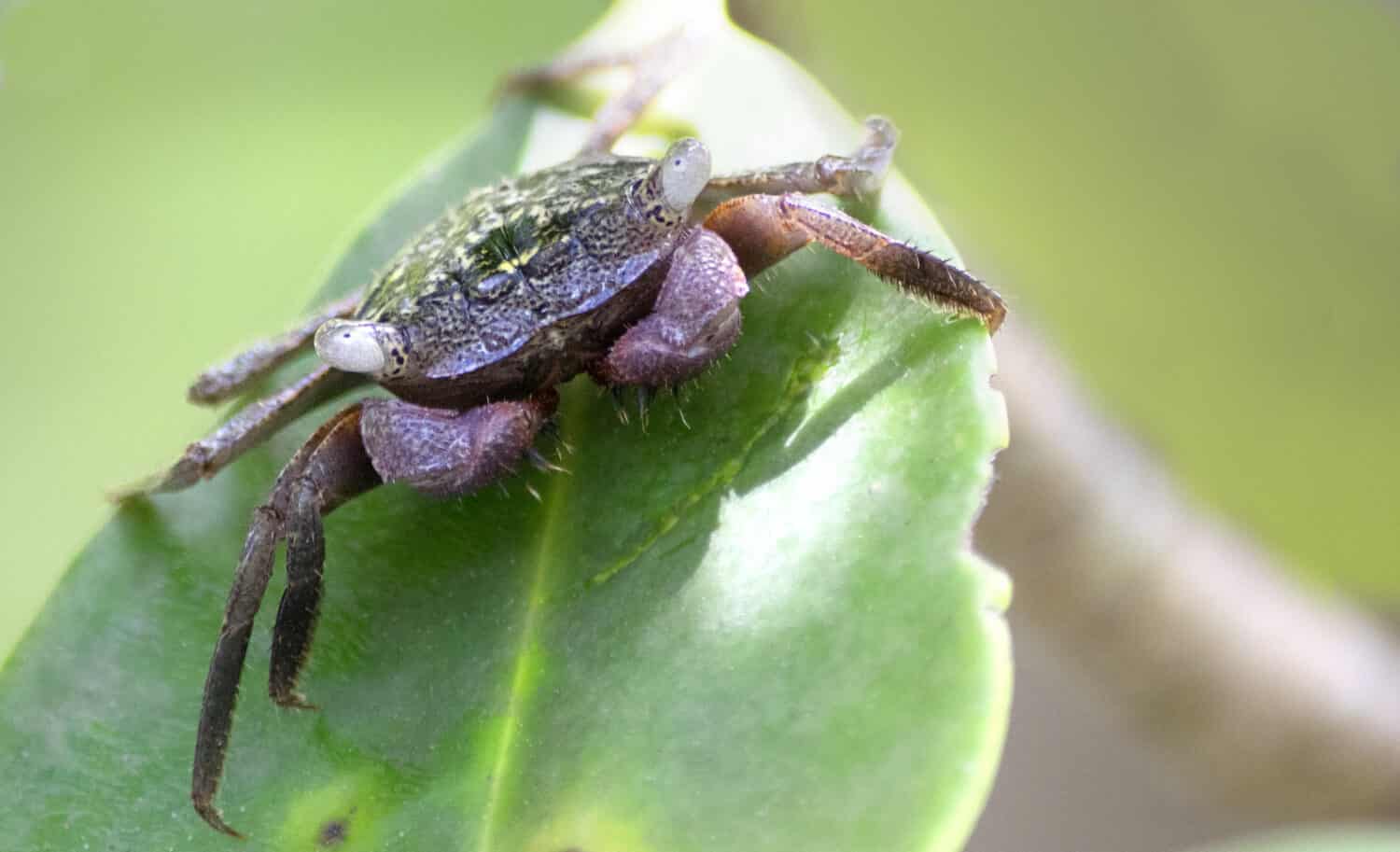
The mangrove tree crab has pointy hairs on its limbs that give it a better grip while climbing mangrove trees.
©K Quinn Ferris/Shutterstock.com
As its common name suggests, the mangrove tree crab is a skilled climber that mainly inhabits mangrove trees along Florida’s coastlines. It’s also one of the Sunshine State’s smallest crabs, averaging just under an inch long. The pointed, raised hairs on its limbs help it climb, and its small, lightweight size allows it to sit comfortably atop the trees’ leaves without weighing them down.
Although the mangrove tree crab most commonly lives in red mangrove trees, it can also sometimes be found in white and black mangrove trees. It is an omnivorous species, but the majority of its diet consists of mangrove tree leaves.
9. Calico Crab (Hepatus epheliticus)
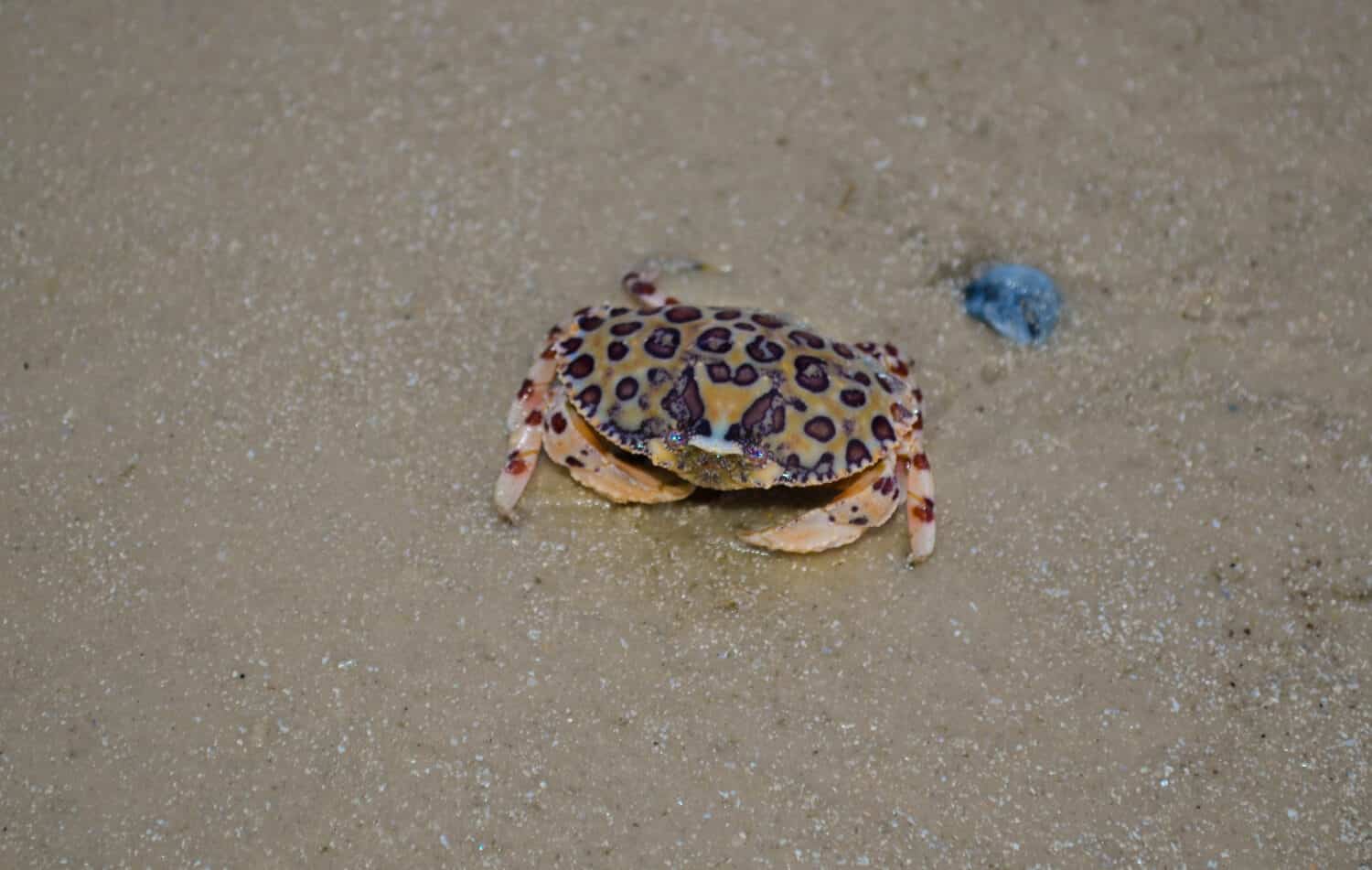
The calico crab is also commonly known as the leopard crab due to its uniquely leopard-like spots on its carapace and limbs.
©Laurel A Egan/Shutterstock.com
The calico crab is known by a few common names, including the leopard crab, due to its unique leopard-like spots adorning its carapace. It’s also sometimes referred to as the Dolly Varden crab, which references the character Dolly Varden from Charles Dickens’ novel Barnaby Rudge. Varden was described as having a rosy blush across her face, and in the 1860s, a type of fabric with lots of small, red spots was often sold as “Dolly Varden fabric.”
Aside from the complicated origins of its common names and bizarrely-colored carapace, the calico crab is quite straightforward as far as Florida’s crabs go. It mainly prefers shallow, coastal waters and is one of Florida’s smaller crabs at just 3 inches long on average.
10. Atlantic Ghost Crab (Ocypode quadrata)
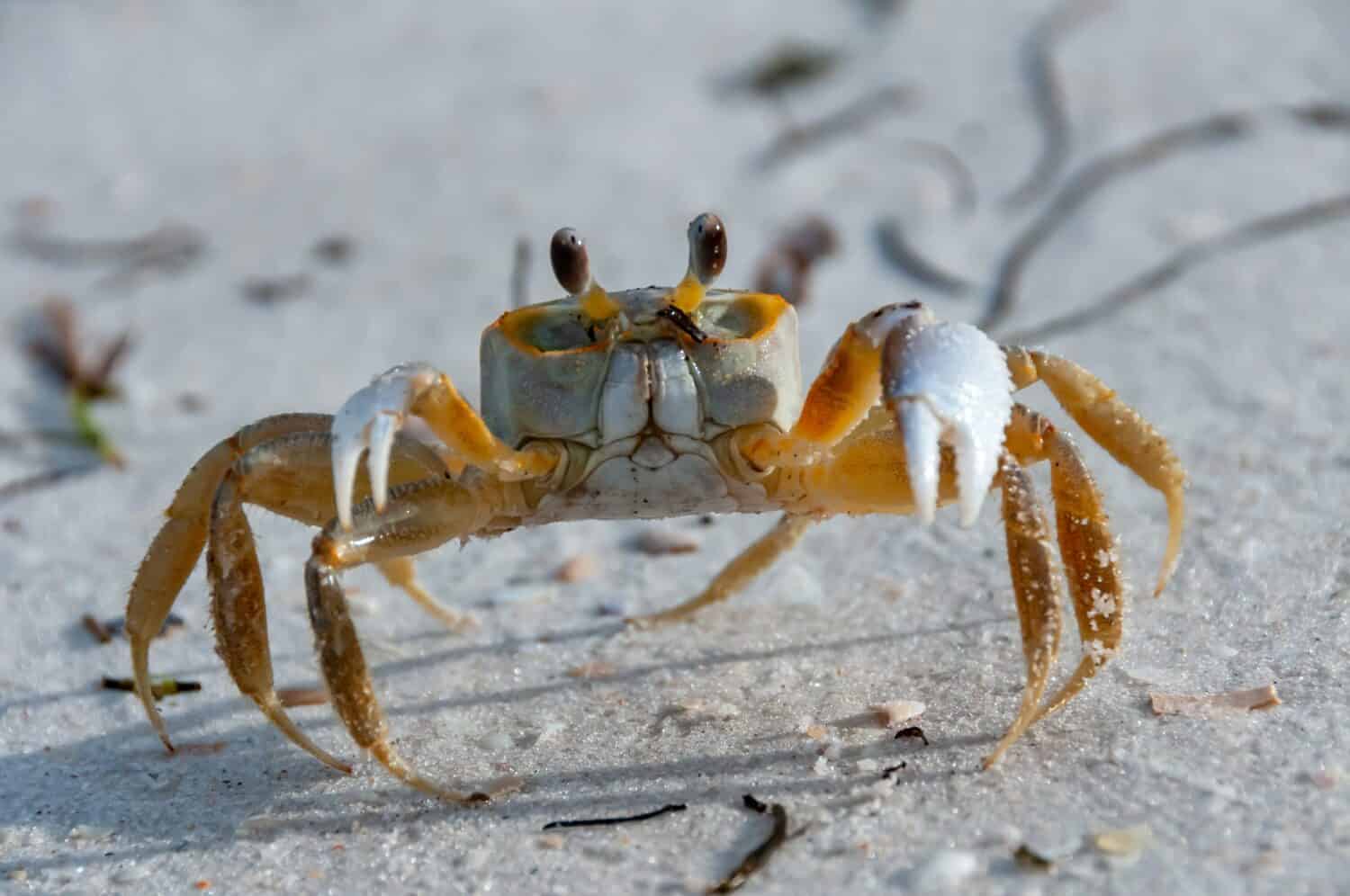
Atlantic ghost crabs can vary in color from orange to light yellow and even pale gray.
©Oleg Kovtun Hydrobio/Shutterstock.com
The Atlantic ghost crab is one of around 20 unique species of ghost crabs, which get their common collective name from their nocturnal nature and typically pale, ghostly gray coloration. Despite their small size, they are skilled burrowers, often digging up to four feet deep into the sandy substrate they inhabit.
Atlantic ghost crabs average just two inches wide when fully mature. They are mainly terrestrial as adults, though they have to occasionally venture into the water to keep their gills moist. Notably, they have well-developed eyes that can rotate 360 degrees, giving them an excellent field of vision.
11. Longnose Spider Crab (Libinia emarginata)
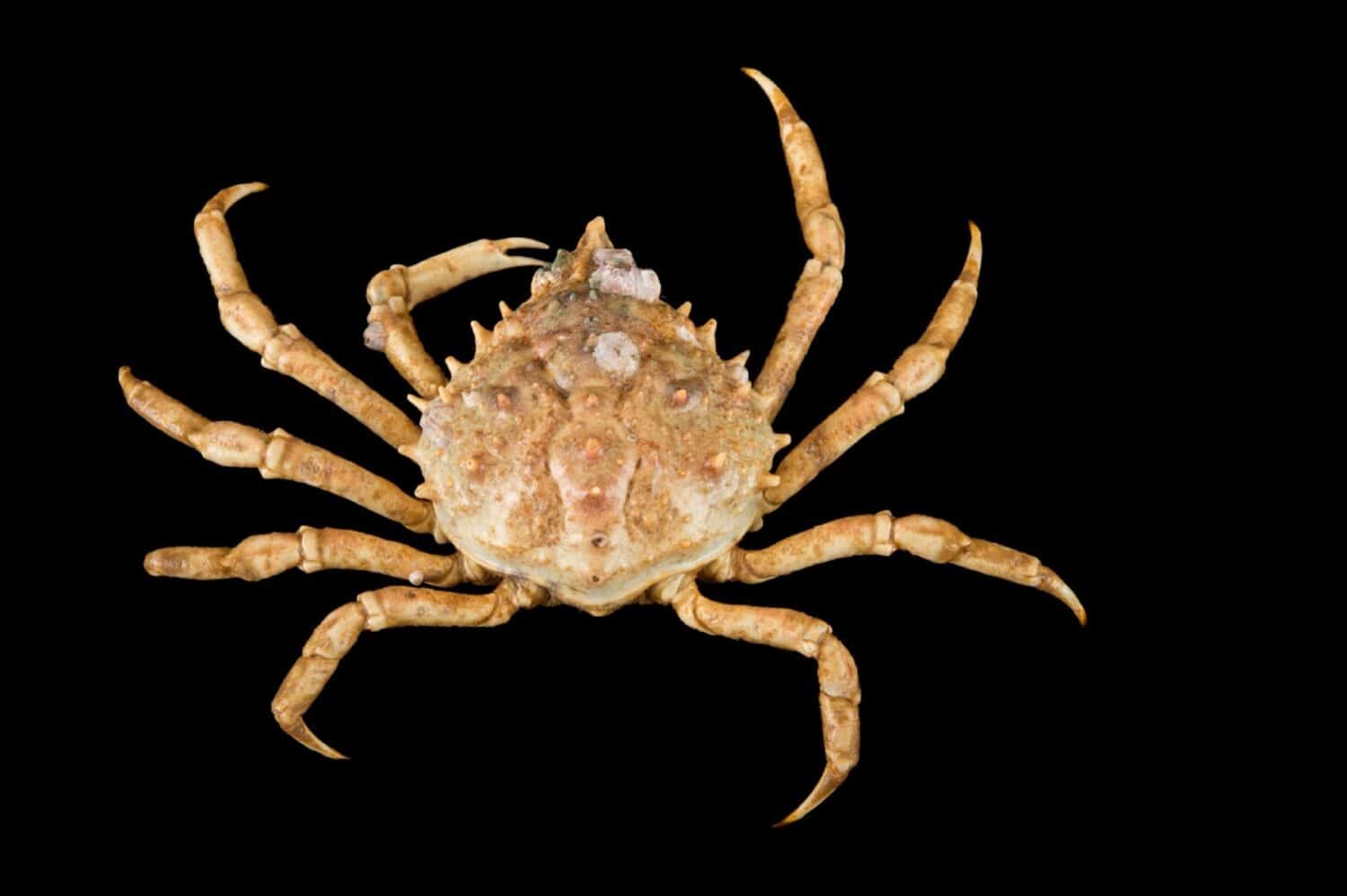
The longnose spider crab is easily recognizable thanks to the pointy, beak-like protrusion of its carapace between its eyes.
©Usha Roy/Shutterstock.com
The longnose spider crab gets its common name from the long, pointed protrusion of its carapace between its eyes and spindly, spider-like legs. Its rounded, spiny carapace averages 2 to 4 inches wide when the crab is fully mature, though males are slightly larger than females.
Longnose spider crabs are found all along North America’s eastern coastlines. They often venture into much deeper water than most crabs, commonly being found as deep as 160 feet. The species also frequents seagrass meadows, which it can use for camouflage and as a food source.
12. Purple Marsh Crab (Sesarma reticulatum)
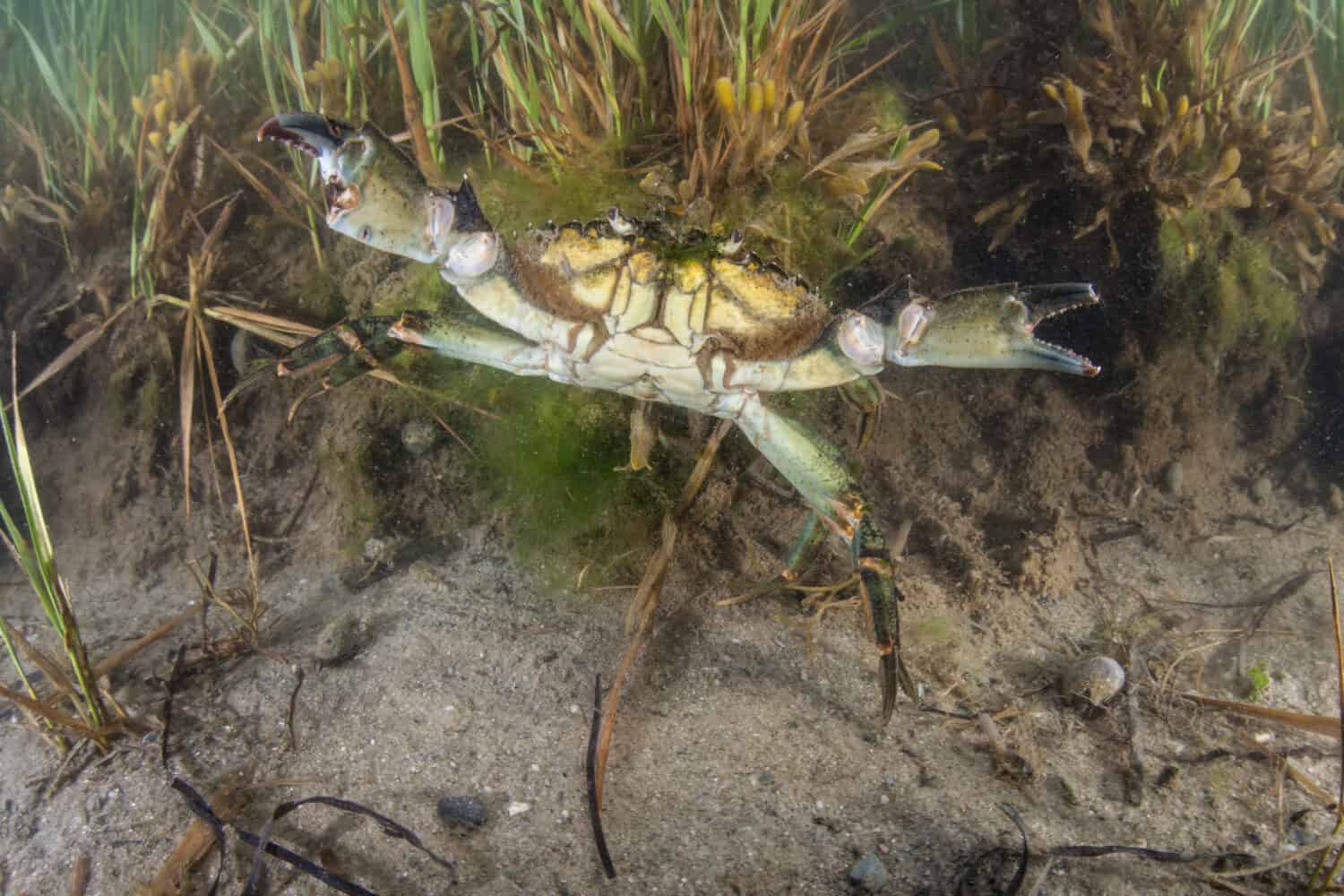
The purple marsh crab’s carapace can vary in color from vibrant purple to dark brown.
©Ethan Daniels/Shutterstock.com
True to its common name, purple marsh crabs primarily inhabit coastal salt marshes. They have a wide geographic range extending from Massachusetts down to central Florida. Unfortunately, they’ve become something of a pest due to overpopulation caused by overfishing of most of their natural predators like cod and dogfish.
Purple marsh crabs mainly feed on grasses common throughout salt marshes like cordgrass. As a result of the species’ overpopulation, salt marshes in Florida and elsewhere along the east coast have significantly eroded and declined. In turn, though, they’ve also proven to be a valuable food source for birds like night herons. Researchers are still unsure of how the purple marsh crab will affect these salt marshes and their resident animal and plant species long-term.
13. Giant Red Hermit Crab (Petrochirus diogenes)
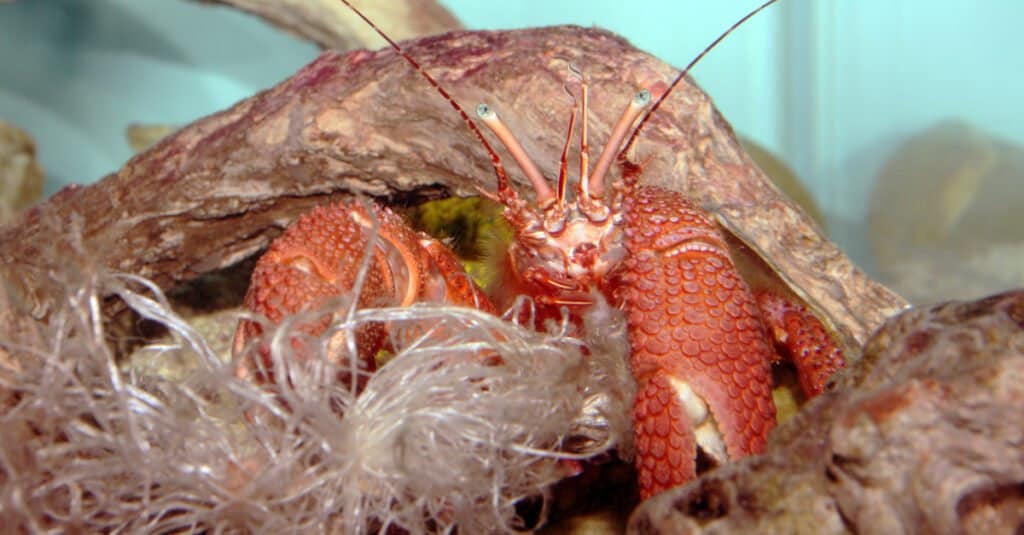
The giant red hermit crab is one of the largest species of hermit crab.
©Joseph M. Arseneau/Shutterstock.com
Of the more than 800 species of hermit crabs, the giant red hermit crab is among the largest. It’s so large that it commonly inhabits the shells of queen conch, which can reach up to 12 inches long!
To obtain their massive conch shells, giant red hermit crabs often attack and eat the mollusks living inside. In turn, the crab gets a meal and a new home. It’s common throughout the Caribbean, though it can be found as far north as North Carolina’s coastlines. As its common name suggests, its body is mostly orange to reddish.
14. Pea Crab (Pinnotheres pisum)
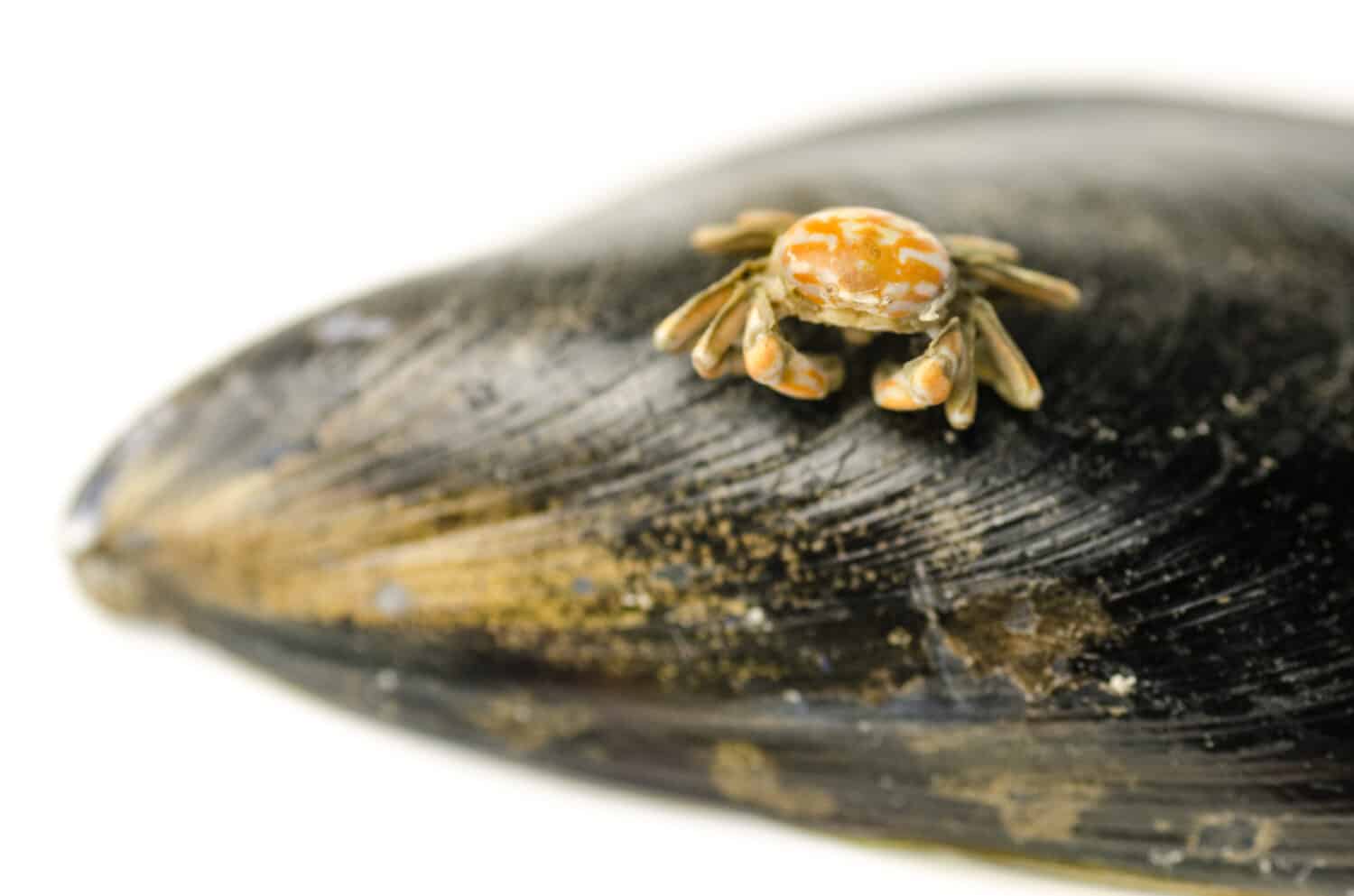
The pea crab is a common parasite of bivalve mollusks.
©mastersky/Shutterstock.com
Up next, we have the smallest crab on our list and one of Florida’s very smallest crabs, the aptly-named pea crab! Averaging just 5 to 10 millimeters long, this unique species is a common parasite of oysters and clams. It enters the shells of these bivalves by quite literally rubbing and tapping them with its claws until they open, allowing it to enter the shell and feed on the mollusk within.
Although bivalve mollusks are the pea crab’s primary hosts, they can parasitize a wide range of species, including sea urchins, sea cucumbers, and sea squirts.
15. Atlantic Blue Crab (Callinectes sapidus)
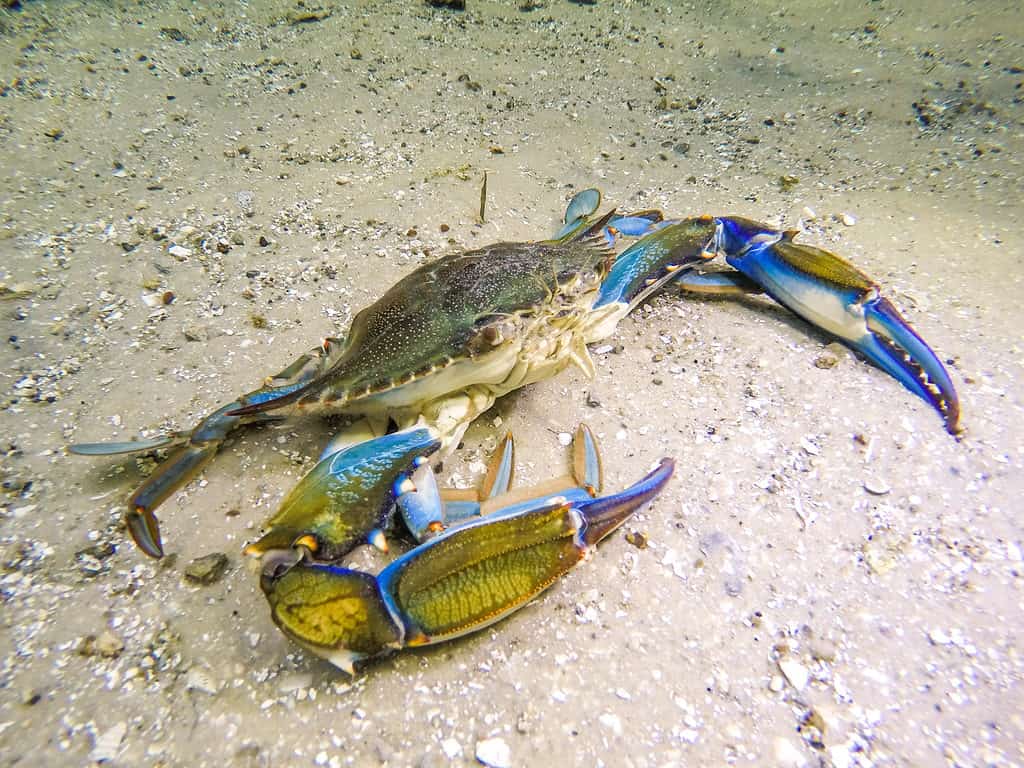
Blue crabs have bright blue limbs and claws, but their carapaces are usually more of a dull, reddish brown color.
©Jen Helton/Shutterstock.com
Although it’s sometimes known as the Chesapeake or Maryland blue crab, this hardy species can be found as far south as the Gulf of Mexico. It’s one of Florida’s most prominent and well-known edible crabs due to its rich, buttery flavor. True to its main common name, its limbs are often a rich, royal blue. Meanwhile, its carapace can range in color from reddish brown to dull orange.
The Atlantic blue crab is also one of Florida’s larger crabs, measuring around 7 to 9 inches wide when fully grown. It exhibits prominent sexual dimorphism, most notably in the size and shape of its carapace and abdomen. While males have a longer, thinner abdomen, females are much wider and rounder in shape.
16. West Indian Spider Crab (Mithrax spinosissimus)

The West Indian spider crab is the largest Caribbean reef crab as well as one of Florida’s largest crabs.
©Jesus Cobaleda/Shutterstock.com
Like most other types of spider crabs, the West Indian spider crab has long, spindly limbs covered in short, pointed spines. It is common throughout Florida as well as the Caribbean Islands. It’s one of Florida’s largest crabs as well as the largest Caribbean reef crab, measuring around 7 inches long and weighing nearly five pounds when fully mature.
Although the West Indian spider crab is an omnivore, not much is known about the details of its diet. It mainly resides in deeper waters in reef caves as deep as 130 feet. Its large, well-developed legs allow it to walk along the ocean floor with ease.
The photo featured at the top of this post is © Dudarev Mikhail/Shutterstock.com
Thank you for reading! Have some feedback for us? Contact the AZ Animals editorial team.






